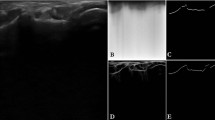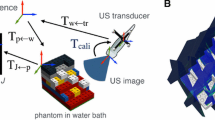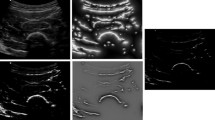Abstract
Ultrasound (US) has been introduced to computer-assisted orthopedic surgery for bone registration owing to its advantages of nonionizing radiation, low cost, and noninvasiveness. However, the registration accuracy is limited by US image distortion caused by variations in the acoustic properties of soft tissues. This paper proposes a soft-tissue sound-speed-aware registration method to overcome the above challenge. First, the feature enhancement strategy of multi-channel overlay is proposed for U2-net to improve bone segmentation performance. Secondly, the sound speed of soft tissue is estimated by simulating the bone surface distance map for the update of US-derived points. Finally, an iterative registration strategy is adopted to optimize the registration result. A phantom experiment was conducted using different registration methods for the femur and tibia/fibula. The fiducial registration error (femur, 0.98 ± 0.08 mm (mean ± SD); tibia/fibula, 1.29 ± 0.19 mm) and the target registration error (less than 2.11 mm) showed the high accuracy of the proposed method. The experimental results suggest that the proposed method can be integrated into navigation systems that provide surgeons with accurate 3D navigation information.
Graphical abstract
First, multi-channel input data including the original image, phase symmetric image, and depth weighted map are fused for U2-net model training in the automatic bone segmentation of US images. When US-derived points are obtained, the sound speed of soft tissue is estimated by simulating the bone surface distance map for the update of the locations of US-derived points. An iterative registration strategy based on the cost function of corresponding point distances is adopted to optimize the registration result. Finally, a gold-standard transformation based on artificial fiducials is constructed for method evaluation.











Similar content being viewed by others
References
Stübig T, Windhagen H, Krettek C, Ettinger M (2020) Computer-assisted orthopedic and trauma surgery. Deutsches Arzteblatt Int 117(47):793–800. https://doi.org/10.3238/arztebl.2020.0793
Petursson G, Fenstad AM, Gøthesen Ø, Dyrhovden GS, Hallan G, Röhrl SM, Aamodt A, Furnes O (2018) Computer-assisted compared with conventional total knee replacement: a multicenter parallel-group randomized controlled trial. J Bone Joint Surg Am Vol 100(15):1265–1274. https://doi.org/10.2106/JBJS.17.01338
Lilly RJ, Koueiter DM, Graner KC, Nowinski GP, Sadowski J, Grant KD (2018) Computer-assisted navigation for intramedullary nail fixation of intertrochanteric femur fractures: a randomized, controlled trial. Injury 49(2):345–350. https://doi.org/10.1016/j.injury.2017.12.006
Richter M (2013) Computer aided surgery in foot and ankle: applications and perspectives. Int Orthop 37(9):1737–1745. https://doi.org/10.1007/s00264-013-1922-5
Honl M, Dierk O, Gauck C, Carrero V, Lampe F, Dries S, Quante M, Schwieger K, Hille E, Morlock MM (2003) Comparison of robotic-assisted and manual implantation of a primary total hip replacement. a prospective study. J Bone Joint Surg Am Vol 85(8):1470–1478. https://doi.org/10.2106/00004623-200308000-00007
Nogler M, Maurer H, Wimmer C, Gegenhuber C, Bach C, Krismer M (2001) Knee pain caused by a fiducial marker in the medial femoral condyle: a clinical and anatomic study of 20 cases. Acta Orthop Scand 72(5):477–480. https://doi.org/10.1080/000164701753532808
Gong RH, Stewart J, Abolmaesumi P (2011) Multiple-object 2-D-3-D registration for noninvasive pose identification of fracture fragments. IEEE Trans Biomed Eng 58(6):1592–1601. https://doi.org/10.1109/TBME.2011.2105487
Nakajima Y, Tashiro T, Sugano N, Yonenobu K, Koyama T, Maeda Y, Tamura Y, Saito M, Tamura S, Mitsuishi M, Sugita N, Sakuma I, Ochi T, Matsumoto Y (2007) Fluoroscopic bone fragment tracking for surgical navigation in femur fracture reduction by incorporating optical tracking of hip joint rotation center. IEEE Trans Biomed Eng 54(9):1703–1706. https://doi.org/10.1109/TBME.2007.900822
Livyatan H, Yaniv Z, Joskowicz L (2003) Gradient-based 2-D/3-D rigid registration of fluoroscopic X-ray to CT. IEEE Trans Med Imaging 22(11):1395–1406. https://doi.org/10.1109/TMI.2003.819288
Sanctorum J, Van Wassenbergh S, Aerts P, Dirckx J (2020) Technical note: correction of geometric x-ray image intensifier distortion based on digital image correlation. Med Phys 47(2):597–603. https://doi.org/10.1002/mp.13944
Otake Y, Armand M, Armiger RS, Kutzer MD, Basafa E, Kazanzides P, Taylor RH (2012) Intraoperative image-based multiview 2D/3D registration for image-guided orthopaedic surgery: incorporation of fiducial-based C-arm tracking and GPU-acceleration. IEEE Trans Med Imaging 31(4):948–962. https://doi.org/10.1109/TMI.2011.2176555
Patil S, Lindley EM, Burger EL, Yoshihara H, Patel VV (2012) Pedicle screw placement with O-arm and stealth navigation. Orthopedics 35(1):e61–e65. https://doi.org/10.3928/01477447-20111122-15
Ikuma H, Hirose T, Takao S, Otsuka K, Kawasaki K (2020) The usefulness and safety of the simultaneous parallel anterior and posterior combined lumbar spine surgery using intraoperative 3D fluoroscopy-based navigation (SPAPS). North Am Spine Soc J 5:100047. https://doi.org/10.1016/j.xnsj.2020.100047
Kotsianos D, Wirth S, Fischer T, Euler E, Rock C, Linsenmaier U, Pfeifer KJ, Reiser M (2004) 3D imaging with an isocentric mobile C-arm comparison of image quality with spiral CT. Eur Radiol 14(9):1590–1595. https://doi.org/10.1007/s00330-004-2316-2
Gueziri HE, Santaguida C, Collins DL (2020) The state-of-the-art in ultrasound-guided spine interventions. Med Image Anal 65:101769. https://doi.org/10.1016/j.media.2020.101769
Noble JA, Navab N, Becher H (2011) Ultrasonic image analysis and image-guided interventions. Interface focus 1(4):673–685. https://doi.org/10.1098/rsfs.2011.0025
Penney GP, Edwards PJ, King AP, Blackall JM, Batchelor PG, Hawkes DJ (2001) A stochastic iterative closest point algorithm (stochastICP). In: Niessen WJ, Viergever MA (eds) Medical Image Computing and Computer-Assisted Intervention – MICCAI 2001. Lecture Notes in Computer Science, vol 2208. Springer, Berlin, Heidelberg, pp 762–769
Wein W, Karamalis A, Baumgartner A, Navab N (2015) Automatic bone detection and soft tissue aware ultrasound-CT registration for computer-aided orthopedic surgery. Int J Comput Assist Radiol Surg 10(6):971–979. https://doi.org/10.1007/s11548-015-1208-z
Brounstein A, Hacihaliloglu I, Guy P, Hodgson A, Abugharbieh R (2015) Fast and accurate data extraction for near real-time registration of 3-D ultrasound and computed tomography in orthopedic surgery. Ultrasound Med Biol 41(12):3194–3204
Niu K, Homminga J, Sluiter VI, Sprengers A, Verdonschot N (2018) Feasibility of A-mode ultrasound based intraoperative registration in computer-aided orthopedic surgery: a simulation and experimental study. PLoS one 13(6):e0199136. https://doi.org/10.1371/journal.pone.0199136
Ciganovic M, Ozdemir F, Pean F, Fuernstahl P, Tanner C, Goksel O (2018) Registration of 3D freehand ultrasound to a bone model for orthopedic procedures of the forearm. Int J Comput Assist Radiol Surg 13(6):827–836. https://doi.org/10.1007/s11548-018-1756-0
Fanti Z, Torres F, Hazan-Lasri E, Gastelum-Strozzi A, Ruiz-Huerta L, Caballero-Ruiz A, Cosío FA (2018) Improved surface-based registration of CT and intraoperative 3D ultrasound of bones. J Healthc Eng 2018:2365178. https://doi.org/10.1155/2018/2365178
Schneider U, Pedroni E, Lomax A (1996) The calibration of CT Hounsfield units for radiotherapy treatment planning. Phys Med Biol 41(1):111–124. https://doi.org/10.1088/0031-9155/41/1/009
Robinson DE, Ophir J, Wilson LS, Chen CF (1991) Pulse-echo ultrasound speed measurements: progress and prospects. Ultrasound Med Biol 17(6):633–646. https://doi.org/10.1016/0301-5629(91)90034-t
Barratt DC, Penney GP, Chan CS, Slomczykowski M, Carter TJ, Edwards PJ, Hawkes DJ (2006) Self-calibrating 3D-ultrasound-based bone registration for minimally invasive orthopedic surgery. IEEE Trans Med Imaging 25(3):312–323. https://doi.org/10.1109/TMI.2005.862736
Penney GP, Barratt DC, Chan CS, Slomczykowski M, Carter TJ, Edwards PJ, Hawkes DJ (2006) Cadaver validation of intensity-based ultrasound to CT registration. Med Image Anal 10(3):385–395. https://doi.org/10.1016/j.media.2006.01.003
Schumann S, Nolte LP, Zheng G (2011) Compensation of sound speed deviations in 3-D B-mode ultrasound for intraoperative determination of the anterior pelvic plane. IEEE Trans Inf Technol Biomed 16(1):88–97. https://doi.org/10.1109/TITB.2011.2170844
Tang S, Yang X, Shajudeen P, Sears C, Taraballi F, Weiner B, Tasciotti E, Dollahon D, Park H, Righetti R (2021) A CNN-based method to reconstruct 3-D spine surfaces from US images in vivo. Med Image Anal 74:102221. https://doi.org/10.1016/j.media.2021.102221
Qin X, Zhang Z, Huang C, Dehghan M, Jagersand M (2020) U2-Net: going deeper with nested U-structure for salient object detection. Pattern Recog 106:107404. https://www.sciencedirect.com/science/article/pii/S0031320320302077, https://doi.org/10.1016/j.patcog.2020.107404. Accessed 2020/10/01
Hacihaliloglu I, Abugharbieh R, Hodgson AJ, Rohling RN (2009) Bone surface localization in ultrasound using image phase-based features. Ultrasound Med Biol 35(9):1475–1487. https://doi.org/10.1016/j.ultrasmedbio.2009.04.015
Cook RL (1984) Shade trees. In: Proceedings of the 11th Annual Conference on Computer Graphics and Interactive Techniques. Association for Computing Machinery, New York, USA, pp 223–231. https://doi.org/10.1145/800031.808602
Long J, Shelhamer E, Darrell T (2015) Fully convolutional networks for semantic segmentation. In: Proceedings of the IEEE Conference on Computer Vision and Pattern Recognition (CVPR), pp 3431–3440
Ronneberger O, Fischer P, Brox T (2015) U-net: convolutional networks for biomedical image segmentation. Medical image computing and computer-assisted intervention-MICCAI 2015: 18th International Conference. Munich, Germany, pp 234–241
Shajudeen PMS, Righetti R (2017) Spine surface detection from local phase-symmetry enhanced ridges in ultrasound images. Med Phys 44(11):5755–5767
Martin K, Spinks D (2001) Measurement of the speed of sound in ethanol/water mixtures. Ultrasound Med Biol 27(2):289–291. https://doi.org/10.1016/s0301-5629(00)00331-8
Wang P, Patel VM, Hacihaliloglu I (2018) Simultaneous segmentation and classification of bone surfaces from ultrasound using a multi-feature guided CNN. In Med Image Comput Comput Assist Interv–MICCAI 2018: 21st Int Conf, Granada, Spain, September 16–20, 2018, Proceedings, Part IV 11 134–142. https://doi.org/10.1007/978-3-030-00937-3_16
Nelder JA, Mead R (1965) A simplex method for function minimization. Comput J 7(4):308–313. https://doi.org/10.1093/comjnl/7.4.308
Alsinan AZ, Patel VM, Hacihaliloglu I (2019) Automatic segmentation of bone surfaces from ultrasound using a filter-layer-guided CNN. Int J Comput Assist Radiol Surg 14(5):775–783. https://doi.org/10.1007/s11548-019-01934-0
Villa M, Dardenne G, Nasan M, Letissier H, Hamitouche C, Stindel E (2018) FCN-based approach for the automatic segmentation of bone surfaces in ultrasound images. Int J Comput Assist Radiol Surg 13:1707–1716. https://doi.org/10.1007/s11548-018-1856-x
Funding
This work was partly supported by the by Tian** Science and Technology Planning Project under Grant 20201193.
Author information
Authors and Affiliations
Contributions
Chuanba Liu, and Tao Sun contributed equally to research design, analysis of data, and drafting of the manuscript. Yimin Song contributed equally to critical revisions of the manuscript as well as approval of the final submission. All authors have read and approved the final submitted manuscript.
Corresponding author
Ethics declarations
Ethics approval and consent to participate
This article used anonymous data from an existing collection of CT scans and does not contain any studies with human participants performed by any of the authors. Informed consent for this type of study is not required.
Competing interests
The authors declare no competing interests.
Additional information
Publisher's Note
Springer Nature remains neutral with regard to jurisdictional claims in published maps and institutional affiliations.
Rights and permissions
Springer Nature or its licensor (e.g. a society or other partner) holds exclusive rights to this article under a publishing agreement with the author(s) or other rightsholder(s); author self-archiving of the accepted manuscript version of this article is solely governed by the terms of such publishing agreement and applicable law.
About this article
Cite this article
Liu, C., Wang, W., Sun, T. et al. Soft-tissue sound-speed-aware ultrasound-CT registration method for computer-assisted orthopedic surgery. Med Biol Eng Comput (2024). https://doi.org/10.1007/s11517-024-03123-x
Received:
Accepted:
Published:
DOI: https://doi.org/10.1007/s11517-024-03123-x




